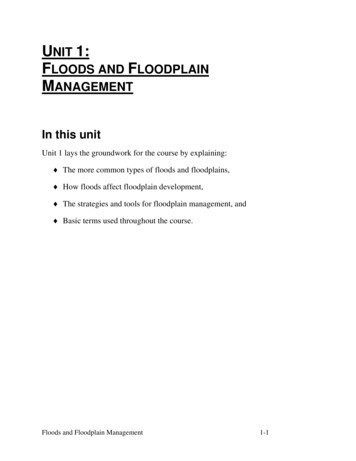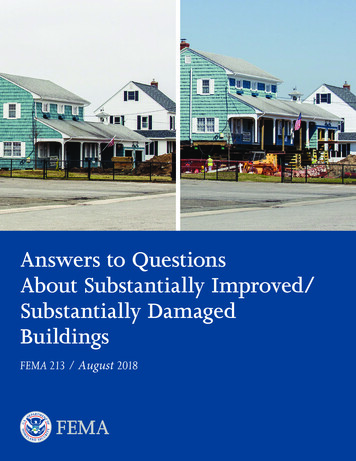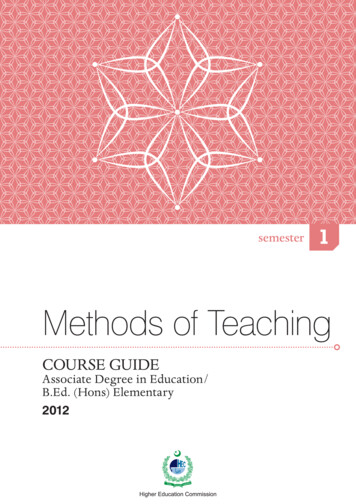
Transcription
UNIT 1:FLOODS AND FLOODPLAINMANAGEMENTIn this unitUnit 1 lays the groundwork for the course by explaining: The more common types of floods and floodplains, How floods affect floodplain development, The strategies and tools for floodplain management, and Basic terms used throughout the course.Floods and Floodplain Management1-1
ContentsIntroduction. 1-4A. Floods and Floodplains . 1-5Riverine Flooding . 1-6Overbank flooding . 1-7Flash flooding . 1-8Riverine erosion . 1-8Coastal flooding . 1-9Coastal storms. 1-9Coastal erosion. 1-10Tsunamis . 1-11Lake flooding . 1-11Shallow Flooding . 1-11Sheet flow . 1-11Ponding . 1-12Urban drainage. 1-12Special Flood Hazards . 1-12Closed basin lakes. 1-13Uncertain flow paths . 1-13Dam breaks . 1-14Ice jams . 1-15Mudflow. 1-15Natural and beneficial floodplain functions. 1-16Natural flood and erosion control . 1-17Biologic resources and functions . 1-17Societal resources and functions. 1-17B. Floodplain Development . 1-19Floodplain Development Dynamics . 1-19Riverine floodplains. 1-19Watersheds. 1-20Coasts. 1-21Flood Damage. 1-22Hydrodynamic forces. 1-22Debris impact . 1-24Hydrostatic forces . 1-25Floods and Floodplain Management1-2
Soaking . 1-25Sediment and contaminants . 1-26Safety and Health Hazards. 1-27C. Floodplain Management. 1-28Evolution. 1-28The Unified National Program for Floodplain Management. 1-29Strategies and tools . 1-30Floodplain Management Strategies. 1-30Strategy 1: Modify human susceptibility to flood damage. 1-30Strategy 2: Modify the impact of flooding . 1-31Strategy 3: Modify flooding itself . 1-31Strategy 4: Preserve and restore natural resources . 1-32Floods and Floodplain Management1-3
INTRODUCTIONThroughout time, floods have altered the floodplain landscape. These areasare continuously shaped by the forces of water—either eroded or built up throughdeposit of sediment. More recently, the landscape has been altered by humandevelopment, affecting both the immediate floodplain and events downstream.Historically, people have been attracted to bodies of water as places for living,industry, commerce and recreation. During the early settlement of the UnitedStates, locations near water provided necessary access to transportation, a watersupply and water power. In addition, these areas had fertile soils, making themprime agricultural lands.This pattern of development continued as communities grew. In recent decades, development along waterways and shorelines has been spurred by theaesthetic and recreational value of these sites.The result has been an increasing level of damage and destruction wrought bythe natural forces of flooding on human development. It is probable that you aretaking this course because your community has experienced some of this. You,yourself, or someone you know may have suffered through a flood and a long,painful and expensive repair and recovery process.The purpose of this study guide is to familiarize you with how this problemcan be curbed through proper management of how your floodplains are developed. Communities that guide development following the standards of theNational Flood Insurance Program have seen the results – their new buildings andneighborhoods have had less damage and suffering from flooding.To start, we need an orientation into the natural processes of flooding. That isthe focus of Section A. Many terms are introduced in this section, such as watershed and coastal erosion that are used throughout the course.Next, we review of the other part of the equation – human development in thepath of that flooding. The final section in this unit discusses the Federal government’s overall floodplain management effort and the other strategies and toolsthat help prevent and reduce flood damage.Floods and Floodplain Management1-4
A. FLOODS AND FLOODPLAINSFloods are part of the Earth’s natural hydrologic cycle.The cycle circulates water throughout the environment (Figure 1-1). This process maintains an overall balance between water in the air, on the surface and inthe ground.Figure 1-1. The Hydrologic cycleSometimes the hydrologic cycle gets outs of balance, sending more water toan area than it can normally handle.The result is a flood.A flood inundates a floodplain. There are different types of floodplains andthey are based on they type of flooding that forms them.Most floods fall into one of three major categories: Riverine flooding Coastal flooding Shallow floodingFloods and Floodplain Management1-5
RIVERINE FLOODINGA watershed is an area that drains into a lake, stream or other body of water.Other names for it are basin or catchment area.Watersheds vary in size. Larger ones can be divided into sub-watersheds.Figure 1-2 shows a watershed and some of the key terms. The boundary of awatershed is a ridge or divide. Water from rain and snowmelt are collected by thesmaller channels (tributaries) which send the water to larger ones and eventuallyto the lowest body of water in the watershed (main channel).Channels are defined features on the ground that carry water through and outof a watershed. They may be called rivers, creeks, streams or ditches. They can bewet all the time or dry most of the time.When a channel receives too much water, the excess flows over its banks andinto the adjacent floodplain. Flooding that occurs along a channel is called riverine flooding.Figure 1-2. Riverine Watershed and FloodplainWhat happens in a watershed will affect events and conditions downstream.Terrain helps determine the dynamics of riverine flooding. In relatively flat areas,shallow, slow-moving floodwater may cover the land for days or even weeks.In hilly and mountainous areas, a flood may come scant minutes after a heavyrain. Such a flash flood gives short notice and moves so fast that it is particularlydangerous to people and property in its path.Floods and Floodplain Management1-6
Overbank floodingThe most common type of flooding in the United States is called overbankflooding (Figure 1-3).Overbank flooding occurs when downstream channels receive more rain orsnowmelt from their watershed than normal, or a channel is blocked by an ice jamor debris. For either reason, excess water overloads the channels and flows outonto the floodplain.Overbank flooding varies with the watershed’s size and terrain. One measureof a flood is the speed of its moving water, which is called velocity. Velocity ismeasured in feet per second.Hilly and mountainous areas have faster moving water, so velocity can pose aserious hazard. In flat areas, the flood may move slowly, making its velocity lessof a hazard.Terrain may affect how much warning people have that a flood is building.Conditions on a river that drains a large watershed may warn of a pending floodhours or even days before actual flooding. On the other hand, streams in hillyareas may give no warning that a flash flood is about to strike.Flood depths vary, as do flood durations. Generally, the larger the river, thedeeper the flood and the longer it will last. However, in hilly or mountainousareas with narrow valleys, flooding can be very deep in small watersheds.Depending on the size of the river and terrain of its floodplain, flooding canlast for days and cover wide areas.Figure 1-3. Riverine floodplainFloods and Floodplain Management1-7
Flash floodingA severe storm that drops much rainfall in a short time can generate a flashflood. All flash floods strike quickly and end swiftly.While flash floods occur in all fifty states, areas with steep slopes and narrowstream valleys are particularly vulnerable, as are the banks of small tributarystreams. In hilly areas, the high-velocity flows and short warning time make flashfloods hazardous and very destructive.In urban areas, flash flooding can occur where impervious surfaces, guttersand storm sewers speed runoff. Flash floods also can be caused by dam failure,the release of ice-jam flooding, or collapse of debris dams.Flash floods rank first as the cause of flood-related deaths in the United States.In the 1970s, four flash floods in a five-year period killed 570 people. Death tollsassociated with the 1993 Mississippi River flood or hurricanes are in anothercategory because such events build over several days, giving people enough timeto evacuate safely. In 1972, 118 people died along Buffalo Creek in West Virginia when anembankment made of coal refuse washed out, destroying 546 houses anddamaging as many more. Weeks later, 236 people died when heavy rain and a dam failure inundatedthe area near Rapid City, South Dakota. Property damage exceeded 100million. In 1976, heavy rains spawned floods in Colorado’s Big Thompson Canyon, killing 139 people. The next year, 77 people died in Johnstown, Pennsylvania, when heavyrain overwhelmed a dam, causing 200 million in damage.Riverine erosionRiver channels change as water moves downstream, acting on the channelbanks and on the channel bottom (the thalweg). This force is made more potentduring a flood, when the river’s velocity increases.Several features along a river are affected by this flow of water in differentways. A meander is a curve in a channel. On the outside of a meander, the banksare subject to erosion as the water scours against them (Figure 1-4). On the otherhand, areas on the inside of meanders receive deposits of sand and sedimenttransferred from the eroded sites.Floods and Floodplain Management1-8
Figure 1- 4. Erosion changes the shape of channelsProperties on the outside ofcurves face a double threat ofinundation and undercutting fromriverine erosion during floods(Figure 1- 5).In addition, meanders do notstay in the same place—they migrate slowly downstream andacross the floodplain, reworkingthe shape of the channel within thefloodplain.Figure 1-5. Riverine erosion can undercutstructuresCOASTAL FLOODINGDevelopment along the coasts of the oceans, the Gulf of Mexico, and largelakes can be exposed to two types of flood problems not found in riverine areas:coastal storms and coastal erosion. The Pacific and Caribbean coasts face a thirdhazard: tsunamis.Coastal stormsHurricanes and severe storms cause most coastal flooding. These include“Nor’easters,” which are severe storms on the Atlantic coast with winds out of thenortheast.Floods and Floodplain Management1-9
Persistent high wind and changes in air pressure push water toward the shore,causing a storm surge which can raise the level of a large body of water by severalfeet. Waves can be highly destructive as they move inland, battering structures intheir path.On open coasts, the magnitude of a flood varies with the tides. An increase inthe level of the ocean during high tide will flood larger areas than a storm thatstrikes during low tide.Major coastal storms can significantly change the shape of shoreline landforms, making sandy coastal floodplains particularly unstable places fordevelopment.Wind and waves shape sand dunes, bluffs and barrier islands. Because theselandforms provide natural buffers from the effects of a storm, their preservation isimportant to the protection of inland development.Coastal erosionLong-term coastal erosion isanother natural process thatshapes shorelines. It is a complexprocess that involves natural andhuman-induced factors. Thenatural factors include sandsources, sand size and density,changes in water level, and theeffects of waves, currents, tidesand wind. These factors determine whether a shoreline willrecede or accrete.Human activity—such asconstruction of groins or seawalls, the dredging of channelsand placement of sandbags—also can contribute to coastalerosion by altering the naturalsystems that transport sand.Figure 1-6. This area of the Maryland shoreshows how erosion can move or remove entireislands over a period as short as 40 years.Floods and Floodplain Management1-10
TSUNAMISAnother hazard along the coast is a tsunami, a large wave often called a “tidalwave” even though tides and tsunamis are not related. Caused by an underwaterearthquake or volcano, a tsunami is a pressure wave that can raise water levels asmuch as 15 feet.In the open ocean, a tsunami’s wave may be only a few feet high. Because thewave’s energy extends from the surface to the bottom, that energy is compressedas the wave approaches shallow water, creating higher, more life-threateningwaves (Figure 1-7).Tsunamis usually occur in the Pacific Ocean, but they have caused floods inthe Caribbean. Because they can happen on a clear day and are not related tostorms, they can catch many people unawares.Figure 1- 7. Tsunami waves increase in shallower water.Lake floodingLake shores can flood in ways similar to ocean coasts. Along the Great Lakes,severe storms can produce waves and cause shoreline erosion. FEMA is startingto map Great Lakes flooding with the same techniques it uses for ocean coastalflooding.SHALLOW FLOODINGShallow flooding occurs in flat areas where a lack of channels means watercannot drain away easily. Shallow flood problems fall into three categories: sheetflow, ponding and urban drainage.Sheet flowWhere there are inadequate or no defined channels, floodwater spreads outover a large area at a somewhat uniform depth in what’s called sheet flow.Sheet flows occur after an intense or prolonged rainfall during which the raincannot soak into the ground. During sheet flow, the floodwaters move downhilland cover a wide area.Floods and Floodplain Management1-11
PondingIn some flat areas, runoff collects in depressions and cannot drain out, creatinga ponding effect. Ponding floodwaters do not move or flow away. Floodwaterswill remain in the temporary ponds until they infiltrate into the soil, evaporate orare pumped out.Ponding is especially a problem in glaciated areas, where glaciers carved outdepressions; in areas where caves and sinkholes are common, and in other areaswhere man-made features, such as roads and railroad embankments, have blockedoutlets.Urban drainageAn urban drainage system comprises the ditches, storm sewers, retentionponds and other facilities constructed to store runoff or carry it to a receivingstream, lake or the ocean. Other man-made features in such a system includeyards and swales that collect runoff and direct it to the sewers and ditches.When most of these systems were built, they were typically designed to handle the amount of water expected during a 10-year storm. Larger storms overloadthem, and the resulting backed-up sewers and overloaded ditches produce shallowflooding.Another urban drainage problem occurs in the areas protected by levees. Being in floodplains, they are flat and don’t drain naturally, especially when a leveeblocks the flow to the river.To drain these areas, channels have been built and pumps installed to mechanically move the water past the levee. Often, these man-made systems do nothave the capacity to handle heavy rains or intense storms.SPECIAL FLOOD HAZARDSThe flooding types described so far are the more common types found in theUnited States. There are many special local situations in which flooding or floodrelated problems do not fit the national norm.This section discusses five of those special flood hazards: Closed basin lakes Uncertain flow paths. Dam breaks. Ice jams. Mudflows.Floods and Floodplain Management1-12
Closed basin lakesThere are two types of closed basin lake: Lakes with no outlets, like the Great Salt Lake, Utah, Devil’s Lake, NorthDakota, and the Salton Sea, California; and Lakes with inadequate, regulated or elevated outlets, such as the GreatLakes and many glacial lakes.Seasonal increases in rainfall cause a closed basin lake’s level to rise fasterthan it can drain. As a result, they are subject to large fluctuations in water surfaceelevation. Floodwaters in closed basin lakes may stay up for weeks, months oreven years.The long periods of high water make closed basin lake flooding particularlyproblematic. Properties may not be heavily damaged, but they are unusable forlong periods because they are surrounded by—or under—water. Buildings areisolated and septic fields are unusable. Properties are exposed to waves (andsometimes ice) that add to the hazard.Uncertain flow pathsThe section on riverine erosion explained that stream channels change theirlocations gradually or only after very large and rare floods. However, in someareas of the country, every flood may change channels.For example, in mountainous areas, high-velocity floodwater picks up sediment and rock. At the base of the valley where the slope flattens out, thefloodwater decreases in speed and spreads out, as in a sheet flow, dropping sediment and rock over a fan-shaped area called an alluvial fan.Figure 1-8 shows how an alluvial fan can have numerous channels. During thenext flood, the channels may be in different locations.Alluvial fan flooding is more common in the mountainous western states,where there is less ground cover and more opportunity for erosion.Alluvial fan floods are not as predictable as riverine floods—one never knowswhere the floodwaters will spread out across the fan. Thus, they pose three hazards: Velocity of floodwaters and the debris they carry. Sediment and debris deposited by the floodwaters. The potential for the channel to move across the fan during the flood.Floods and Floodplain Management1-13
Figure 1-8. An alluvial fan can have numerous channels.The arid west is subject to another type of flooding that features uncertainflow paths, known as movable stream beds.When a high-velocity flood runs through an area with sand or loose soil, theerosion and sedimentation can occur so fast that the stream channel can be lowered, filled in or relocated through processes known as degradation, aggradationand migration. In some cases, these processes may occur simultaneously, or oneprocess may occur in one flood and another process in a later event.Dam breaksA break in a dam can produce an extremely dangerous flood situation becauseof the high velocities and large volumes of water released by such a break. Sometimes they can occur with little or no warning on clear days when people are notexpecting rain, much less a flood.Breaching often occurs within hours after the first visible signs of dam failure,leaving little or no time for evacuation. (As noted in the earlier section on flashflooding, three of the four top killer floods in the 1970s were related to the failureof a dam or dam-like structure.)Dam breaks occur for one of three reasons: The foundation fails due to seepage, settling or earthquake. The design, construction, materials or operation were deficient.Floods and Floodplain Management1-14
Flooding exceeds the capacity of the dam’s spillway.Proper design can prevent dam breaks. While dam safety programs can ensurethat new dams are properly designed, there are still many private or locally builtdams that were poorly designed and maintained.Ice jamsIce jam flooding generally occurs when warm weather and rain break up frozen rivers or any time there is a rapid cycle of freezing and thawing.The broken ice floats downriver until it is blocked by an obstruction such as abridge or shallow area (Figure 1-9). An ice dam forms, blocking the channel andcausing flooding upstream.Figure 1-9. Likely Ice Jam AreasIce jams present three hazards: Sudden flooding of areas upstream from the jam, often on clear days withlittle or no warning. Movement of ice chunks (floes) that can push over trees and crush buildings (see Figure 1-18). Sudden flooding of areas downstream when an ice jam breaks. The impactis similar to a dam break, damaging or destroying buildings and structures.MudflowA mudflow is a type of landslide that occurs when runoff saturates the ground.Soil that is dry during dry weather turns into a liquid solution that slides downhill.Floods and Floodplain Management1-15
They typically cause more damage than clear-water flooding due to the combination of debris and sediment, and the force of the debris-filled water.The NFIP officially defines a “mudslide (i.e. mudflow)” as “a condition wherethere is a river, flow or inundation of liquid mud down a hillside usually as aresult of a dual condition of loss of brush cover, and the subsequent accumulationof water on the ground preceded by a period of unusually heavy or sustainedrain.” The NFIP provides flood insurance coverage for mudslides that meet thisdefinition, but does not map or require floodplain management measures in theseareas.What many people view as mudfloods are technically landslides and are notcovered by the NFIP.Figure 1-10. Mudflows are caused by saturated soilNATURAL AND BENEFICIAL FLOODPLAIN FUNCTIONSFloodplain lands and adjacent waters combine to form a complex, dynamicphysical and biological system found nowhere else. When portions of floodplainsare preserved in their natural state, or restored to it, they provide many benefits toboth human and natural systems.Some are static conditions—such as providing aesthetic pleasure—and someare active processes, such as reducing the number and severity of floods, helpinghandle stormwater runoff and minimizing non-point water pollution. For example,by allowing floodwater to slow down, sediments settle out, thus maintainingwater quality. The natural vegetation filters out impurities and uses excess nutrients.Such natural processes cost far less money than it would take to build facilities to correct flood, stormwater, water quality and other community problems.Floods and Floodplain Management1-16
Natural resources of floodplains fall into three categories: water resources, living resources and societal resources. The following sections describe eachcategory’s natural and beneficial functions.Natural flood and erosion controlOver the years, floodplains develop their own ways to handle flooding anderosion with natural features that provide floodwater storage and conveyance,reduce flood velocities and flood peaks, and curb sedimentation.Natural controls on flooding and erosion help to maintain water quality by filtering nutrients and impurities from runoff, processing organic wastes andmoderating temperature fluctuations.These natural controls also contribute to recharging groundwater by promoting infiltration and refreshing aquifers, and by reducing the frequency andduration of low surface flows.Biologic resources and functionsFloodplains enhance biological productivity by supporting a high rate of plantgrowth. This helps to maintain biodiversity and the integrity of ecosystems.Floodplains also provide excellent habitats for fish and wildlife by serving asbreeding and feeding grounds. They also create and enhance waterfowl habitats,and help to protect habitats for rare and endangered species.Societal resources and functionsPeople benefit from floodplains through the food they provide, the recreational opportunities they afford and the scientific knowledge gained in studyingthem.Wild and cultivated products are harvested in floodplains, which are enhancedagricultural land made rich by sediment deposits. They provide open space, whichmay be used to restore and enhance forest lands, or for recreational opportunitiesor simple enjoyment of their aesthetic beauty.Floodplains provide areas for scientific study and outdoor education. Theycontain cultural resources such as historic or archaeological sites, and thus provide opportunities for environmental and other kinds of studies.These natural resources and functions can increase a community’s overallquality of life, a role that often has been undervalued. By transforming stream andriver floodplains from problem areas into value-added assets, the community canimprove its quality of life.Floods and Floodplain Management1-17
Parks, bike paths, open spaces, wildlife conservation areas and aesthetic features are important to citizens. Assets like these make the community moreappealing to potential employers, investors, residents, property owners and tourists.Figure 1-11 Floodplains offer recreation and aesthetic benefits.Floods and Floodplain Management1-18
B. FLOODPLAIN DEVELOPMENTThroughout time, floods have altered the floodplain landscape. These areasare continuously shaped by the forces of water—either eroded or built up throughdeposit of sediment. More recently, the landscape has been altered by humandevelopment, affecting both the immediate floodplain and events downstream.Historically, people have been attracted to bodies of water as places for living,industry, commerce and recreation. During the early settlement of the UnitedStates, locations near water provided necessary access to transportation, a watersupply and water power. In addition, these areas had fertile soils, making themprime agricultural lands.This pattern of development continued as communities grew. In recent decades, development along waterways and shorelines has been spurred by theaesthetic and recreational value of these sites.Because floodplains have attracted people and industry, a substantial portionof this country’s development is now subject to flooding. Floodplains account foronly seven percent of the nation’s total land area. However, they contain a tremendous amount of property value. It is estimated that there are 8 – 10 millionhouseholds in our floodplains.Two problems result from floodplain development: Development alters the floodplain and the dynamics of flooding. Buildings and infrastructure are damaged by periodic flooding.FLOODPLAIN DEVELOPMENT DYNAMICSHuman development can have an adverse impact on floods and floodplains.Three types of problems are reviewed here.Riverine floodplainsThe most obvious impact of development on riverine flooding comes withmoving or altering channels or constructing bridges and culverts with small openings. Construction and regrading of the floodplain can obstruct or divert water toother areas. Levees and dikes are the best known examples of this, but even smallconstruction projects have an impact (Figure 1-12).Floods and Floodplain Management1-19
Filling obstructs flood flows, backing up floodwaters onto upstream and adjacent properties. It also reduces the floodplain’s ability to store excess water,sending more water downstream and causing floods to rise to higher levels. Thisalso increases floodwater velocity.Figure 1-12. Effects of development on a riverine floodplainWatershedsDevelopment in riverinewatershedsaffectstherunoff of sto
A. FLOODS AND FLOODPLAINS Floods are part of the Earth's natural hydrologic cycle. The cycle circulates water throughout the environment (Figure 1-1). This pro-cess maintains an overall balance between water in the air, on the surface and in










